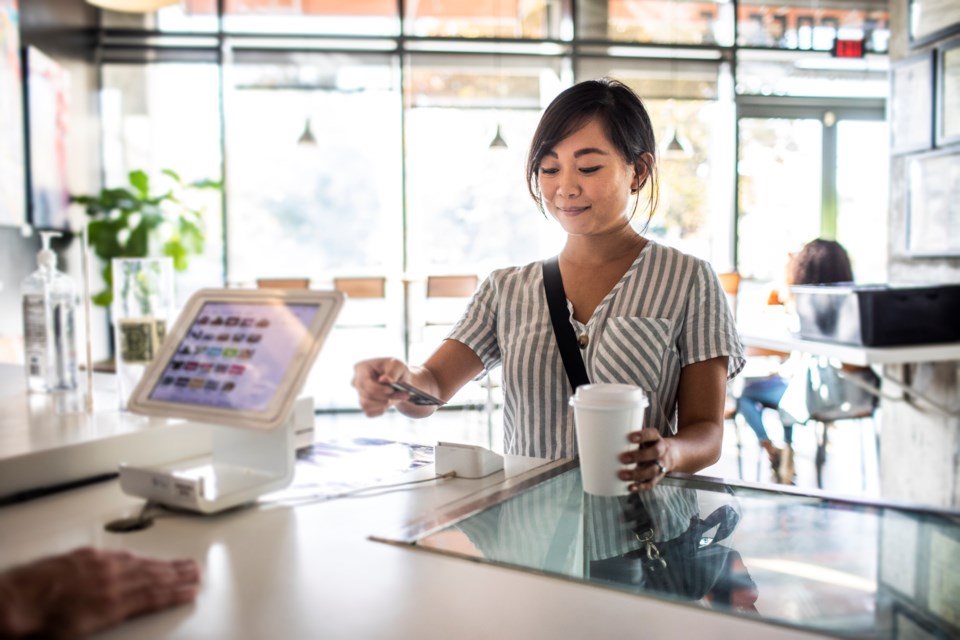I was listening to a podcast recently when I heard a few phrases that struck me to my core.
The podcast is called Flightless Bird, hosted by a journalist named David Farrier. The self-proclaimed “New Zealander who ended up accidentally marooned in America” delves into a series of American (more often North American) customs that aren’t as common elsewhere.
For example, tipping. It wasn’t so much the host’s confusion about what to do when the bill comes at a restaurant that resonated—I’d like to think that after about a decade spent serving and bartending part-time, I’ve got that one dialled—but about what to do when you’re standing at a counter.
“I stand in line in a café to pay for a coffee, and I’m presented with a giant, illuminated screen requesting a tip,” Farrier explains in the episode’s introduction. “The barista and the line of customers watches on as my finger hovers over the screen: 15 per cent or 25 per cent? I feel like I’m on a game show and if I pick the wrong option, the floor will drop out from under me and I’ll plunge into a pond of crocodiles where I’ll be torn limb from limb.”
Maybe “struck me to my core” was a little dramatic, but I fully related to the sudden-onset, pressure-induced panic when the iPad flips around and you’re calculating in your head just how big of a tip the sandwich and kombucha or latte and take-home bag of coffee beans you’re purchasing warrants.
Clearly, I’m not alone in questioning what the etiquette is these days. A post in the Whistler Winter Facebook group last week posed the question. “Takeout: to tip or not to tip?” It netted 170 answers and, as usual, sparked some fairly fierce debates about the pros and cons of tipping as a practice, without a whole lot of consensus.
Among the topics disputed: do tips represent a service charge that you shouldn’t need to pay if you’re not receiving table service throughout the meal? Or does someone sourcing, preparing and packaging the food that you pick up still count as service, in that context? What does a typical tip-out structure look like in takeout settings?
Like a lot of commenters on that thread, I find tipping prompts popping up more often, too, but I’ll still tip in almost every situation where it’s an option, even if I tend to leave slightly less for quick counter service than a two-hour, sit-down meal.
I mostly view it as a gesture that hopefully helps support locals making it work in this town—we all know wages haven’t necessarily crept up at the same rate inflation has. Is it always necessary? Maybe not, some argue, but aside from another few dollars out of my account there’s no real downside, plus it’s better safe than sorry, in the event employees need to tip-out a portion of their takeout sales coworkers. And, as a service worker myself, I fully believe in tip karma.
But like most people in their twenties who live in Whistler and work two jobs, I still need to be at least somewhat fiscally responsible. My struggle is with figuring out just how much is appropriate in those greyer areas.
During the pandemic, when takeout was the only option if you wanted to eat something that wasn’t prepared in your own kitchen, it seemed like society generally rallied behind front-line and hospitality workers, recognizing the heightened impact pandemic restrictions had on these industries and raising tips accordingly. Are those inflated numbers—and, maybe, expectations—sticking around now that those restrictions are gone?
Probably, it appears. A survey conducted by Restaurants Canada in April 2022 found 44 per cent of Canadians surveyed reported leaving higher tips when dining out compared to pre-COVID. The survey related specifically to table-service, but I’d guess takeout tips would follow a similar trend.
A less-scientific poll conducted on Pique’s website this week asked readers how much they normally tip on takeout or counter service. Just under a quarter of respondents said they typically don’t tip; while 12 per cent of respondents leave five per cent of the cost. A 10 per cent tip was the most popular option, selected by 33 per cent of respondents, while 22 per cent of respondents said they tip 15 per cent; three per cent usually leaving an 18-per-cent tip and five per cent normally tipping at least 20 per cent.
Say what you will about North American tipping culture—yes, there are some worthy arguments to abolish it, but I think most can agree it is too entrenched to change anytime soon—at the end of the day, it’s still technically optional.
Deciding whether to tip the person making your latte five per cent or 10 per cent or 15 per cent or 20 per cent or 30 per cent is probably not as awkward as both I and David Farrier make it out to be, and realistically, there’s no pool of crocodiles waiting to snap up customers if they choose the wrong option. When it comes to takeout, spend your money however makes you feel most comfortable. Maybe just put yourself in the shoes of the person who’s packing up your to-go order first.




